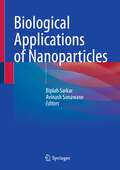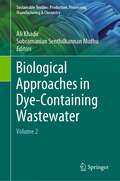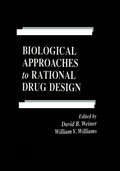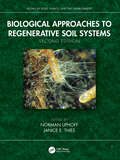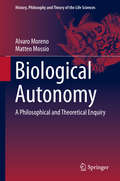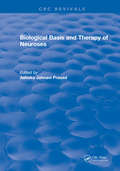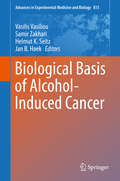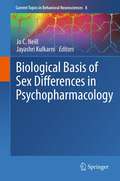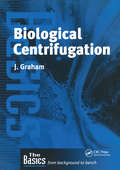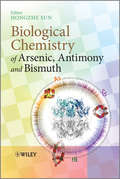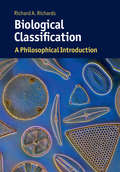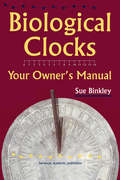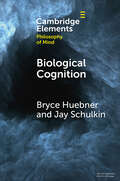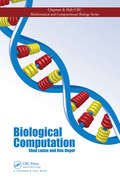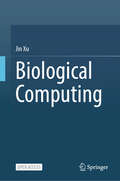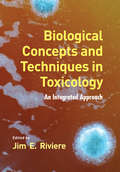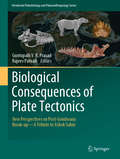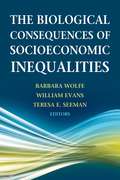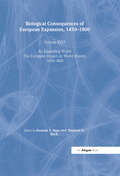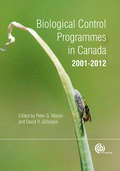- Table View
- List View
Biological Applications of Nanoparticles
by Biplab Sarkar Avinash SonawaneThis textbook for graduate and postgraduate students provides comprehensive applications of nanoparticles in medicine, agriculture, and environmental sciences. The initial chapter covers basic topics related to types, synthesis, structure, and properties of various nanoparticles. It further discusses the wide range of applications of nanoparticles in medicine, agriculture, and the environment. The book presents nano-electronic biosensors that are used to diagnose and monitor the progression of human diseases. It summarizes the opportunities and challenges of nanotechnology in the agriculture and food sector highlighting the scientific, technical, regulatory, safety, and societal impacts. Additionally, it illustrates the applications of nanotechnology in the field of aquaculture medicine, bioinformatics and food technology. The textbook examines the development and administration of nano-medicines , their applications, advantages, and limitations for the treatment and prophylaxis of a broad range of diseases. Lastly, the textbook explores the recent advances in the field of nanobusiness and nanotechnology issues in intellectual property management( IPR).
Biological Approaches in Dye-Containing Wastewater: Volume 1 (Sustainable Textiles: Production, Processing, Manufacturing & Chemistry)
by Subramanian Senthilkannan Muthu Ali KhadirThe textile industry segment has been continuously expanding and it is reported that the global market was US$1000 billion in 2020. Aside from the fact that textile industry could be profitable and offers several advantages for human life, this industry produces wastewater containing many harmful substances in the form of organic and inorganic moieties. Textile wastewater can lead to serious environmental problems if discharged without treatment. In this first volume of the application of biological mechanisms, processes and units are reviewed in terms of dye degradation and removal. The role of biodegradation, bioaccumulation and biosorption in bio-decolorization are discussed. The book starts with highlighting the fundamentals of aerobic and anaerobic mechanisms having different configurations. The moving bed bioreactor (MBBR), up-flow anaerobic sludge blanket reactors, sequential aerobic/anaerobic batch reactors, membrane bioreactor, etc are also covered in this edition.
Biological Approaches in Dye-Containing Wastewater: Volume 2 (Sustainable Textiles: Production, Processing, Manufacturing & Chemistry)
by Subramanian Senthilkannan Muthu Ali KhadirThis Volume 2 contains essential contributions highlighting the use of biotechnology in dye removal. It begins with an overview of activated sludge process for dye removal along with its limitation is carried out and describes the fundamental concepts of dye-containing textile wastewater treatments, particularly microbial and enzymatic approaches, including the most usual textile wastewater treatments and their trends. It discusses the role microbial biofilms play when employed in the integrated treatment system for effective detoxification, degradation and complete mineralization of pollutants in dye waste effluents. It assesses the most recent advances in the biotransformation of synthetic dyes from wastewater, especially anthraquinone-typed dyes. Phycoremediation as an emerging and efficient technology in dye removal, remediation strategies used by microalgae, and the role of fungi in the dye removal are presented.
Biological Approaches to Rational Drug Design
by David B. Weiner William V. WilliamsThis book exploits an understanding of disease pathogenesis by applying a variety of biological agents to therapy. It provides a broad overview of the current methodologies being applied to biological approaches to rational drug design and in depth analyses of progress in this specific field.
Biological Approaches to Regenerative Soil Systems (Books in Soils, Plants, and the Environment)
by David Montgomery Stephen Wood Jules Pretty Norman Uphoff Andrew S. Ball Olivier Husson Mark Laing Radha Prasanna Janice E. Thies Febri Doni Odo PrimavesiAgriculture in the 21st century will need considerable modification to remain both productive and sustainable. Greater production is needed to meet the needs of our still-growing populations and to combat hunger and poverty. Declines in soil health and the pollution of water sources are making many of our production systems less tenable. These adverse trends are exacerbated more and more by the impacts of climate change. There are, fortunately, alternative methods available for agricultural practice that can countervail these constraints. Biological Approaches to Regenerative Soil Systems brings together the work of both researchers and practitioners to map out better approaches to contemporary agriculture that draw upon both old and new knowledge. It presents the science that underlies more biologically driven strategies as well as contemporary innovative experiences in diverse parts of the world. Both accepted research and these varied experiences encourage confidence that these approaches, not relying primarily on the introduction of new varieties and on exogenous inputs, can succeed. This book updates and revises a preceding volume Biological Approaches to Sustainable Soil Systems published by CRC Press in 2006. So much has been learned and done on this subject in the past decade and a half that a second edition was warranted. For instance, the first edition was published, knowledge about plant-soil microbiomes, which are a frequent focus in this book, has mushroomed. Because sustainability is a broad term and an end-state, the editors preferred to assemble expertise regarding regenerative agriculture, which is concerned with the means for achieving sustainability. The concept of regenerative soil systems, entities that are more complex and multifaceted than "soil" alone, also incorporates a concern with having more resilient agricultural systems, ones that are better able to cope with the multiple stresses of climate change that are foreseen for the decades ahead. The book’s chapters representing a wide range of disciplines were contributed by 84 scientists and practitioners from 20 countries. Although they come from persons with in-depth knowledge of their respective fields, the chapters are written to be accessible to readers who are not trained in the specialized subjects. Taken together, the chapters provide students, researchers, practitioners, planners, and policy makers with a comprehensive understanding of both the science and the steps needed to regenerate and sustain soil systems around the world for the long-term benefit of humankind and the environment.
Biological Autonomy: A Philosophical and Theoretical Enquiry (History, Philosophy and Theory of the Life Sciences #12)
by Alvaro Moreno Matteo MossioSince Darwin, Biology has been framed on the idea of evolution by natural selection, which has profoundly influenced the scientific and philosophical comprehension of biological phenomena and of our place in Nature. This book argues that contemporary biology should progress towards and revolve around an even more fundamental idea, that of autonomy. Biological autonomy describes living organisms as organised systems, which are able to self-produce and self-maintain as integrated entities, to establish their own goals and norms, and to promote the conditions of their existence through their interactions with the environment. Topics covered in this book include organisation and biological emergence, organisms, agency, levels of autonomy, cognition, and a look at the historical dimension of autonomy. The current development of scientific investigations on autonomous organisation calls for a theoretical and philosophical analysis. This can contribute to the elaboration of an original understanding of life - including human life - on Earth, opening new perspectives and enabling fecund interactions with other existing theories and approaches. This book takes up the challenge.
Biological Basis and Therapy of Neuroses
by Ashoka PrasadParadoxically, it is the termneurosis more than perhaps any other which has the implication of organic basis. Possibly the popular but erroneous belief that it implies impeded systematic biological research in this area. On scrutiny, it becomes obvious that there is considerable evidence for a biological basis to these hitherto ignored conditions. This book endeavours to present this information in a systematic manner.
Biological Basis of Alcohol-Induced Cancer (Advances in Experimental Medicine and Biology #815)
by Samir Zakhari Vasilis Vasiliou Helmut K. Seitz Jan B. HoekIn the recent years, a significant amount of research has emerged connecting the link between alcohol and cancer. The field has rapidly advanced, especially since the complex connection between alcohol and cancer has several unique sub areas that are being investigated. This proceedings volume will contain chapters based upon the presentation of the 2nd International Conference on Alcohol and Cancer in Colorado, 2013. The various topics explore the affects of alcohol on: liver and breast cancer; cell signaling and cancer; stem cells; biomarkers and metabolomics; aerodigestive cancers; cancer and the immune system and more.
Biological Basis of Sex Differences in Psychopharmacology (Current Topics in Behavioral Neurosciences #8)
by Jayashri Kulkarni Jo C. NeillSex matters! Are there differences between the sexes when it comes to brain function and the behaviours that result? This volume attempts to answer this fundamental question. If the answer is 'yes' then this should impact upon our approach to treating mental illness in humans, and to modelling it in animals, as we look for aetiological and pharmacological solutions.
Biological Centrifugation
by Dr John GrahamAn important introduction to the use of the centrifuge in the biology laboratory, Biological Centrifugation is also useful for more experienced workers. The book describes the background and the principles behind centrifugation, including sedimentation theory. The book also considers the different types of centrifuge and other centrifuge hardware available, density gradient media and gradient technology. Although aimed primarily at the novice, this title also provides information to allow more experienced workers to modify and update existing techniques.
Biological Chemistry of Arsenic, Antimony and Bismuth
by Hongzhe SunArsenic, antimony and bismuth, three related elements of group 15, are all found in trace quantities in nature and have interesting biological properties and uses. While arsenic is most well known as a poison - and indeed the contamination of groundwater by arsenic is becoming a major health problem in Asia - it also has uses for the treatment of blood cancer and has long been used in traditional chinese medicine. Antimony and bismuth compounds are used in the clinic for the treatment of parasitic and bacterial infections.Biological Chemistry of Arsenic, Antimony and Bismuth is an essential overview of the biological chemistry of these three elements, with contributions from an international panel of experts. Topics covered include:chemistry of As, Sb and Bibiological chemistry of arsenicbiological chemistry of Sb and Biarsenic and antimony speciation in environmental and biological samplesarsenic in traditional chinese medicinearsenic in aquifersbiomethylation of As, Sb and Biuptake of metalloids by cellsbismuth complexes of porphyrins and their potential in medical applicationsHelicobacter pylori and bismuthmetabolism of arsenic trioxide in blood of the acute promyelocytic leukemia patientsanticancer properties of As, Sb and Biradio-Bi in cancer therapygenotoxicity of As, Sb and Bimetallomics as a new technique for As, Sb and Bimetalloproteomics for As, Sb and BiBiological Chemistry of Arsenic, Antimony and Bismuth conveys the essential aspects of the bioinorganic chemistry of these three elements, making this book a valuable complement to more general bioinorganic chemistry texts and more specialized topical reviews. It will find a place on the bookshelves of practitioners, researchers and students working in bioinorganic chemistry and medicinal chemistry.
Biological Classification: A Philosophical Introduction (Cambridge Introductions to Philosophy and Biology)
by Richard A. RichardsModern biological classification is based on the system developed by Linnaeus, and interpreted by Darwin as representing the tree of life.But despite its widespread acceptance, the evolutionary interpretation has some problems and limitations. <P><P> This comprehensive book provides a single resource for understanding all the main philosophical issues and controversies about biological classification. It surveys the history of biological classification from Aristotle to contemporary phylogenetics and shows how modern biological classification has developed and changed over time. Readers will also be able to see how biological classification is in part a consequence of human psychology, language development and culture. <P>The book will be valuable for student readers and others interested in a range of topics in philosophy and biology.<P> Comprehensive, covering all the main philosophical issues in biological classification<P> Includes a survey of the history of biological classification from Aristotle to the present<P> Naturalistic, in the sense that it begins with what the sciences tell us about the cultural, psychological and linguistic foundations of biological classification
Biological Clocks
by Susan BinkleyBiological Clocks introduces the subject of human chronobiology. It describes biological clocks; why we have clocks; how biological clocks relate to sleep disorders, depression, and jet lag; and how the reader can measure his/her own rhythms.
Biological Clocks, Rhythms, and Oscillations: The Theory of Biological Timekeeping (The\mit Press Ser.)
by Daniel B. ForgerAn introduction to the mathematical, computational, and analytical techniques used for modeling biological rhythms, presenting tools from many disciplines and example applications.All areas of biology and medicine contain rhythms, and these behaviors are best understood through mathematical tools and techniques. This book offers a survey of mathematical, computational, and analytical techniques used for modeling biological rhythms, gathering these methods for the first time in one volume. Drawing on material from such disciplines as mathematical biology, nonlinear dynamics, physics, statistics, and engineering, it presents practical advice and techniques for studying biological rhythms, with a common language. The chapters proceed with increasing mathematical abstraction. Part I, on models, highlights the implicit assumptions and common pitfalls of modeling, and is accessible to readers with basic knowledge of differential equations and linear algebra. Part II, on behaviors, focuses on simpler models, describing common properties of biological rhythms that range from the firing properties of squid giant axon to human circadian rhythms. Part III, on mathematical techniques, guides readers who have specific models or goals in mind. Sections on “frontiers” present the latest research; “theory” sections present interesting mathematical results using more accessible approaches than can be found elsewhere. Each chapter offers exercises. Commented MATLAB code is provided to help readers get practical experience. The book, by an expert in the field, can be used as a textbook for undergraduate courses in mathematical biology or graduate courses in modeling biological rhythms and as a reference for researchers.
Biological Cognition (Elements in Philosophy of Mind)
by Jay Schulkin Bryce HuebnerThis Element introduces a biological approach to cognition, which highlights the significance of allostatic regulation and the navigation of challenges and opportunities. It argues that cognition is best understood as a juggling act, which reflects numerous ongoing attempts to minimize disruptions while prioritizing the sources of information that are necessary to satisfy social and biological needs; and it provides a characterization of the architectural constraints, neurotransmitters, and affective states that shape visual perception, as well as the regulatory capacities that sustain flexible patterns of thought and behavior.
Biological Collections: Ensuring Critical Research And Education For The 21st Century
by Division on Earth and Life Studies Board on Life Sciences National Academies of Sciences, Engineering, and Medicine Committee on Biological Collections: Their Past, Present, and Future Contributions and Options for Sustaining ThemBiological collections are a critical part of the nation's science and innovation infrastructure and a fundamental resource for understanding the natural world. Biological collections underpin basic science discoveries as well as deepen our understanding of many challenges such as global change, biodiversity loss, sustainable food production, ecosystem conservation, and improving human health and security. They are important resources for education, both in formal training for the science and technology workforce, and in informal learning through schools, citizen science programs, and adult learning. However, the sustainability of biological collections is under threat. Without enhanced strategic leadership and investments in their infrastructure and growth many biological collections could be lost. Biological Collections: Ensuring Critical Research and Education for the 21st Century recommends approaches for biological collections to develop long-term financial sustainability, advance digitization, recruit and support a diverse workforce, and upgrade and maintain a robust physical infrastructure in order to continue serving science and society. The aim of the report is to stimulate a national discussion regarding the goals and strategies needed to ensure that U.S. biological collections not only thrive but continue to grow throughout the 21st century and beyond.
Biological Computation (Chapman & Hall/CRC Computational Biology Series)
by Ehud Lamm Ron UngerThe area of biologically inspired computing, or biological computation, involves the development of new, biologically based techniques for solving difficult computational problems. A unified overview of computer science ideas inspired by biology, Biological Computation presents the most fundamental and significant concepts in this area. In the book
Biological Computing
by Jin XuThis open access book comprehensively introduces biocomputing, focusing on its foundational theories, experimental operations, and computational models. Biocomputing represents an innovative computational paradigm that leverages biomolecules as a carrier for processing and storing information. As a core enabler of human progress, computational tools serve as critical benchmarks of societal advancement and are key drivers of technological innovation. While electronic computers currently dominate as the primary instruments for information processing, their underlying manufacturing technologies are approaching physical and practical limits. This has prompted the search for alternative computational models and tools to meet the demands of future advancements. Over recent decades, scientists have explored various fields to develop novel computational frameworks. These efforts have led to the emergence of groundbreaking paradigms, such as artificial neural networks inspired by brain-like information processing, evolutionary computing based on genetic mechanisms, biocomputing utilizing the unique properties of biomolecules, quantum computing exploiting quantum phenomena, and optical computing leveraging the properties of light. Designed as an essential resource for readers interested in the principles and applications of biocomputing, this book establishes a foundational understanding of the subject while serving as a bridge to more advanced theoretical and practical exploration. A basic knowledge of molecular biology is recommended for readers to engage with the material fully. The translation was done using artificial intelligence. Subsequently, a human revision was done primarily in terms of content.
Biological Concepts and Techniques in Toxicology: An Integrated Approach
by Jim E. RiviereHighlighting the latest advances in molecular biology, mathematical modeling, quantitative risk assessment, and biopharmaceutical development, this reference presents how current scientific applications and methods impact and revolutionize mainstream toxicological research. Presenting findings from disciplines that will impact the future of toxicol
Biological Consequences of Plate Tectonics: New Perspectives on Post-Gondwana Break-up–A Tribute to Ashok Sahni (Vertebrate Paleobiology and Paleoanthropology)
by Guntupalli V. R. Prasad Rajeev PatnaikThis book recognizes and celebrates the contributions of Professor Ashok Sahni to the field of paleontology. Prof. Sahni established a School of Vertebrate Palaeontology at Panjab University, Chandigarh, India, where he trained many of today’s vertebrate paleontologists of India. The book covers topics on evolutionary patterns, macroevolutionary events, origination and radiation events, changes in physical environments & climate and their implications for biodiversity dynamics, intercontinental affinities and biogeographic connections in a plate tectonic framework. The book begins by exploring India in the age of the dinosaurs, discussing new fossil remains from the Jurassic Era, then moves through the Cretaceous and Eocene to provide a picture on faunal and floral changes in Gondwanaland in the context of plate tectonics. Furthermore, the book explores the evolutionary patterns and biotic dispersals that resulted from the northward drift of Indian plate during the Cretaceous and its collision with Asia in the Eocene. The respective chapters reveal the role of plate tectonics and climate in shaping the geographical distribution of plants and animals in Gondwana, specifically in India, as well as the post-India/Asia collision implications for biodiversity changes and biogeography in the region’s continental environments. Given its scope, the book will appeal to vertebrate paleontologists, evolutionary biologists, and paleobiogeographers.
Biological Consequences of Socioeconomic Inequalities, The
by Barbara Wolfe Teresa E. Seeman William EvansSocial scientists have repeatedly uncovered a disturbing feature of economic inequality: people with larger incomes and better education tend to lead longer, healthier lives. This pattern holds across all ages and for virtually all measures of health, apparently indicating a biological dimension of inequality. But scholars have only begun to understand the complex mechanisms that drive this disparity. How exactly do financial well-being and human physiology interact? The Biological Consequences of Socioeconomic Inequalities incorporates insights from the social and biological sciences to quantify the biology of disadvantage and to assess how poverty gets under the skin to impact health. Drawing from unusually rich datasets of biomarkers, brain scans, and socioeconomic measures, Biological Consequences of Socioeconomic Inequalities illustrates exciting new paths to understanding social inequalities in health. Barbara Wolfe, William N. Evans and Nancy Adler begin the volume with a critical evaluation of the literature on income and health, providing a lucid review of the difficulties of establishing clear causal pathways between the two variables. In their chapter, Arun S. Karlamangla, Tara L. Gruenewald, and Teresa E. Seeman outline the potential of biomarkers—such as cholesterol, heart pressure, and C-reactive protein—to assess and indicate the factors underlying health. Edith Chen, Hannah M. C. Schreier, and Meanne Chan reveal the empirical power of biomarkers by examining asthma, a condition steeply correlated with socioeconomic status. Their analysis shows how stress at the individual, family, and neighborhood levels can increase the incidence of asthma. The volume then turns to cognitive neuroscience, using biomarkers in a new way to examine the impact of poverty on brain development. Jamie Hanson, Nicole Hair, Amitabh Chandra, Ed Moss, Jay Bhattacharya, Seth D. Pollack, and Barbara Wolfe use a longitudinal Magnetic Resonance Imaging (MRI) study of children between the ages of four and eighteen to study the link between poverty and limited cognition among children. Michelle C. Carlson, Christopher L. Seplaki, and Teresa E. Seeman also focus on brain development to examine the role of socioeconomic status in cognitive decline among older adults. Featuring insights from the biological and social sciences, Biological Consequences of Socioeconomic Inequalities will be an essential resource for scholars interested in socioeconomic disparities and the biological imprint that material deprivation leaves on the human body.
Biological Consequences of the European Expansion, 1450–1800 (An Expanding World: The European Impact on World History, 1450 to 1800 #26)
by Stephen V. Beck’Wherever the European has trod, death seems to pursue the aboriginal.’ So wrote Charles Darwin in 1836. Though there has been considerable discussion concerning their precise demographic impact, reflected in the articles here, there is no doubt that the arrival of new diseases with the Europeans (such as typhus and smallpox) had a catastrophic effect on the indigenous population of the Americas, and later of the Pacific. In the Americas, malaria and yellow fever also came with the slaves from Africa, themselves imported to work the depopulated land. These diseases placed Europeans at risk too, and with some resistance to both disease pools, Africans could have a better chance of survival. Also covered here is the controversy over the origins of syphilis, while the final essays look at agricultural consequences of the European expansion, in terms of nutrition both in North America and in Europe.
Biological Control
by George E. Nicholas J. Mills HeimpelBiological control is the suppression of populations of pests and weeds by living organisms. These organisms can provide important protection from invasive species and protect our environment by reducing the need for pesticides. However, they also pose possible environmental risks, so biological control interventions must be undertaken with great care. This book enhances our understanding of biological control interactions by combining theory and practical application. Using a combination of historical analyses, theoretical models and case studies, with explicit links to invasion biology, the authors cover biological control of insects, weeds, plant pathogens and vertebrate animals. The book reflects increasing recognition of risks over the past 20 years, and incorporates the latest technological advances and theoretical developments. It is ideal for researchers and students of biological control and invasion biology.
Biological Control Programmes in Canada 2001-2012
by Charles Vincent Rob Bourchier Alec Mcclay Joan Cossentine Tara D Gariepy Rob Mcgregor Peter Mason Guy Boivin Barry Lyons Kevin D Floate Tim Haye Rosemarie De Clerck-Floate Naomi Cappuccino Christian Hébert Gary Peng Jacques Brodeur Howard Thistlewood David R Gillespie Jean J Turgeon Gilles Boiteau Paul Abram John Gavloski Dave Langor Bruce Broadbent Laura Timms Neil Holliday Alan Watson Sue M Boyetchko Martin Erlandson Hector CárcamoCanada is a world leader in biological control research. Reporting the status of biocontrol agents released in Canada over the last decade, this book presents case studies by target pest that evaluate the impact of biocontrol and recommend future priorities. In addition to a new chapter on future targets and an appendix listing established agents, this edition contains information of interest to a global audience, and chapters that address effects of invasive species and climate change.
Biological Control Programmes in Canada 2001-2012
by Charles Vincent Rob Bourchier Joan Cossentine Tara D Gariepy Guy Boivin Barry Lyons Kevin D Floate Tim Haye Rosemarie De Clerck-Floate Naomi Cappuccino Christian Hébert Gary Peng Jacques Brodeur Howard Thistlewood Jean J Turgeon Gilles Boiteau Paul Abram John Gavloski Dave Langor Bruce Broadbent Laura Timms Neil Holliday Alan Watson Sue M Boyetchko Martin Erlandson Hector Cárcamo Alec McClay Rob McGregorCanada is a world leader in biological control research. Reporting the status of biocontrol agents released in Canada over the last decade, this book presents case studies by target pest that evaluate the impact of biocontrol and recommend future priorities. In addition to a new chapter on future targets and an appendix listing established agents, this edition contains information of interest to a global audience, and chapters that address effects of invasive species and climate change.
